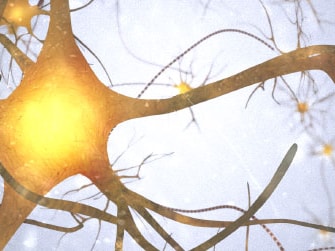Biological Clock 101: The Neuroendocrine Theory of Aging
November 8, 2016
3 min. read

Neuroendocrine cells are chemical messengers of the endocrine system, passing signals from one neuron to the next, and from a neuron to a target cell across a synapse. The endocrine system, in which these messengers operate, regulates body composition, fat deposition, skeletal mass, muscle strength, metabolism, body weight, and physical well-being. Multiple endocrine changes evolve with aging in all species and, not surprisingly, some of the physiologic manifestations of aging that we see clinically are related to the effects of declining neuroendocrine levels.
Reduced Neural and Hormonal Control
In humans, aging is associated with decreased production of hormones, amino acids, peptides, monoamines, and enzymes. These include declines in estrogen in females (menopause) and testosterone in males (andropause); acetylcholine, norepinephrine, serotonin, catecholamine, gamma-amino butyric acid, dopamine, glutamate, and endorphins, to name a few.
With age, lower neuroendocrine levels result in a slower conduction velocity. This translates to slower transmission of current at the synapse, a slower dispersion of current into the target tissue and a resultant slower response, regardless of the tissue. For example, consider a delayed, less effective muscle contraction with a corresponding delay in muscle response. In other words, we lose functional responsiveness with age.
Functional changes in the neuroendocrine system are accompanied by or regulated by decrements throughout the organism. Humans experience cascading functional loss and its potential sequelae. The lack of endocrines weakens the neural and hormonal controls, reducing the bodys ability to maintain homeostasis. From a clinical standpoint, older people are slower to obtain homeostasis during activity, require longer cooling down time after exercise, and are less receptive to temperature changes, increasing the incidence of hyper- and hypothermia.
Criticism
The importance of neuroendocrine study as it relates to aging, functional activity and neuromuscular function cannot be overemphasized. That said, critics of the neuroendocrine theories point out that the master timekeeper of aging the neuroendocrine system lacks universality. Many organisms that age (e.g., higher vertebrates) have no complex neuroendocrine system. It can also be argued that the changes in the neuroendocrine system are expected and occur in all tissues.
Aging of the brain produces secondary effects that although not a fundamental part contribute to aging. The neuroendocrine contributions to aging manifest as the lack of energy, poor metabolism, decreased muscle strength, diminished bone density, and progressively poorer vascularity.
A Major Role in Aging
The neuroendocrine theories view the functional decline in neurons and their associated hormones as central to aging. Given the major role the neuroendocrine system plays in physiology, this is an attractive theory of aging and neuroendocrine disease.





